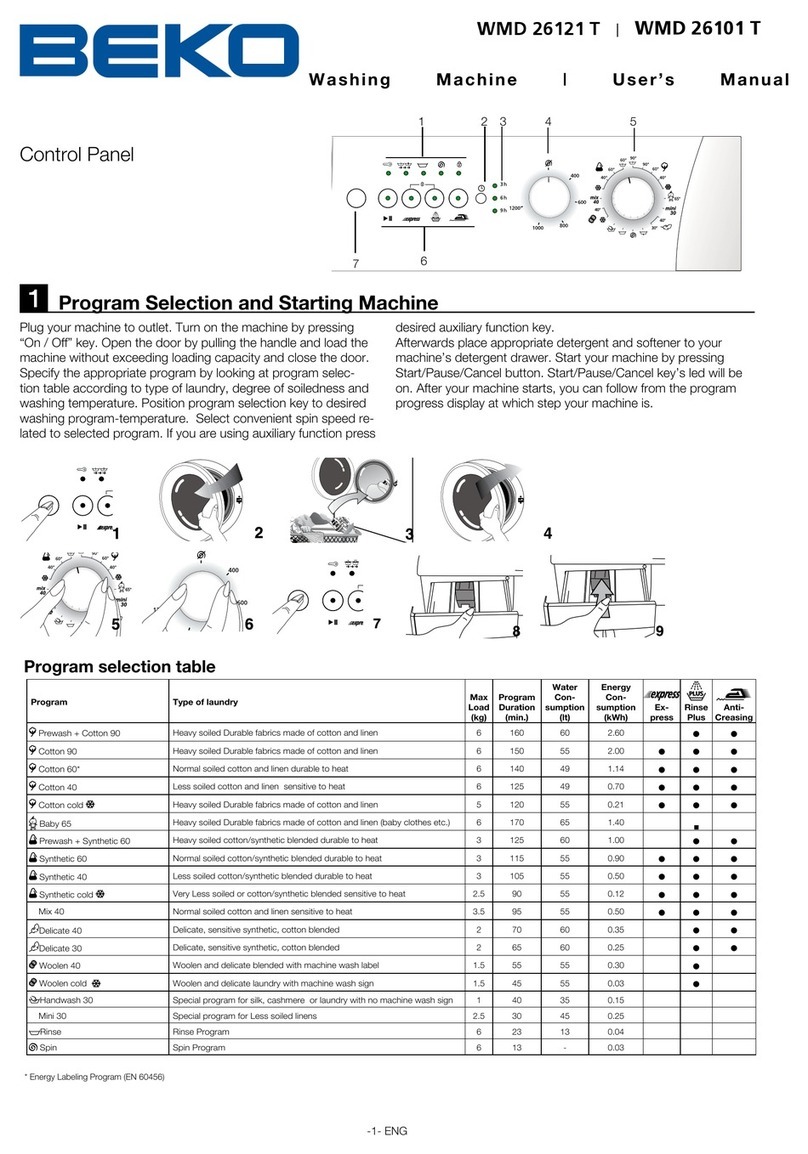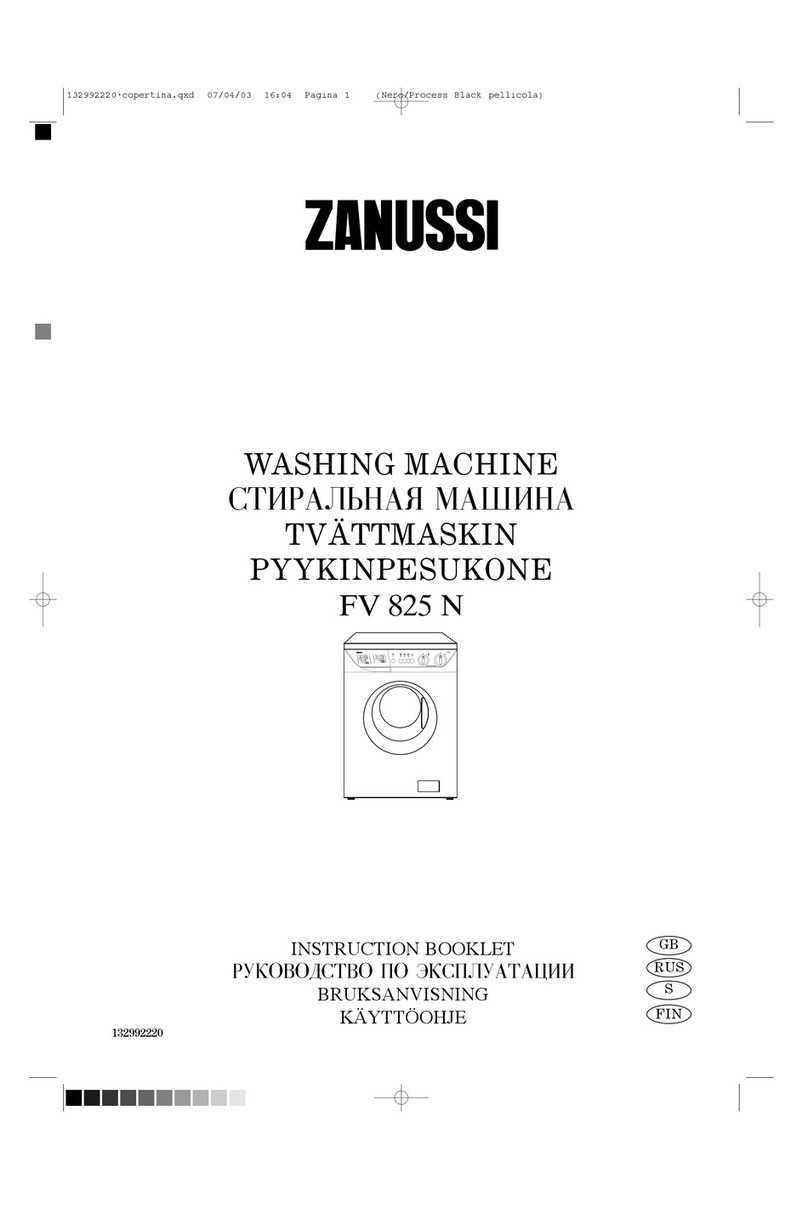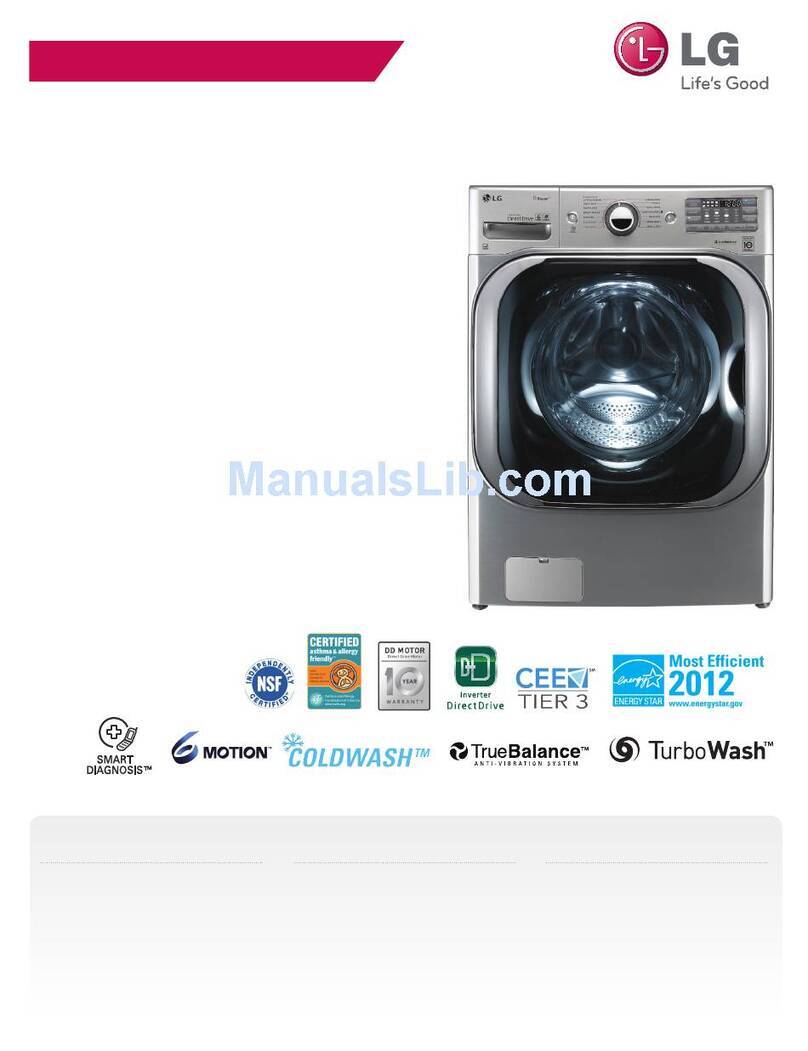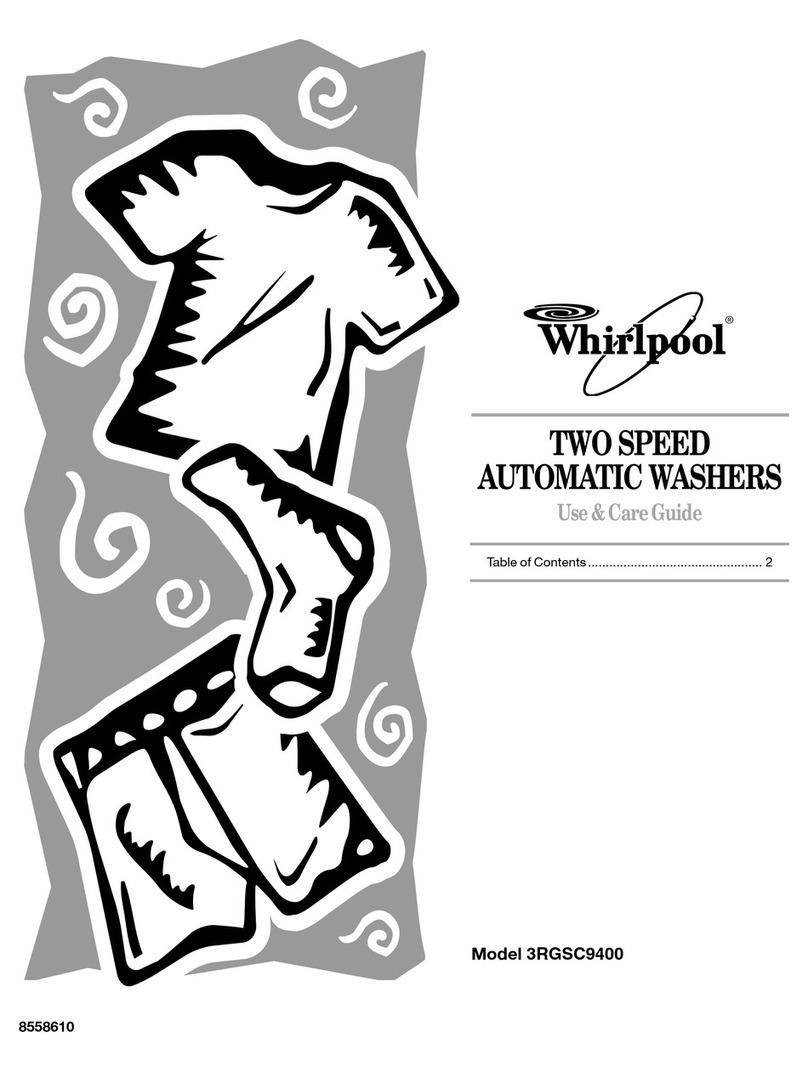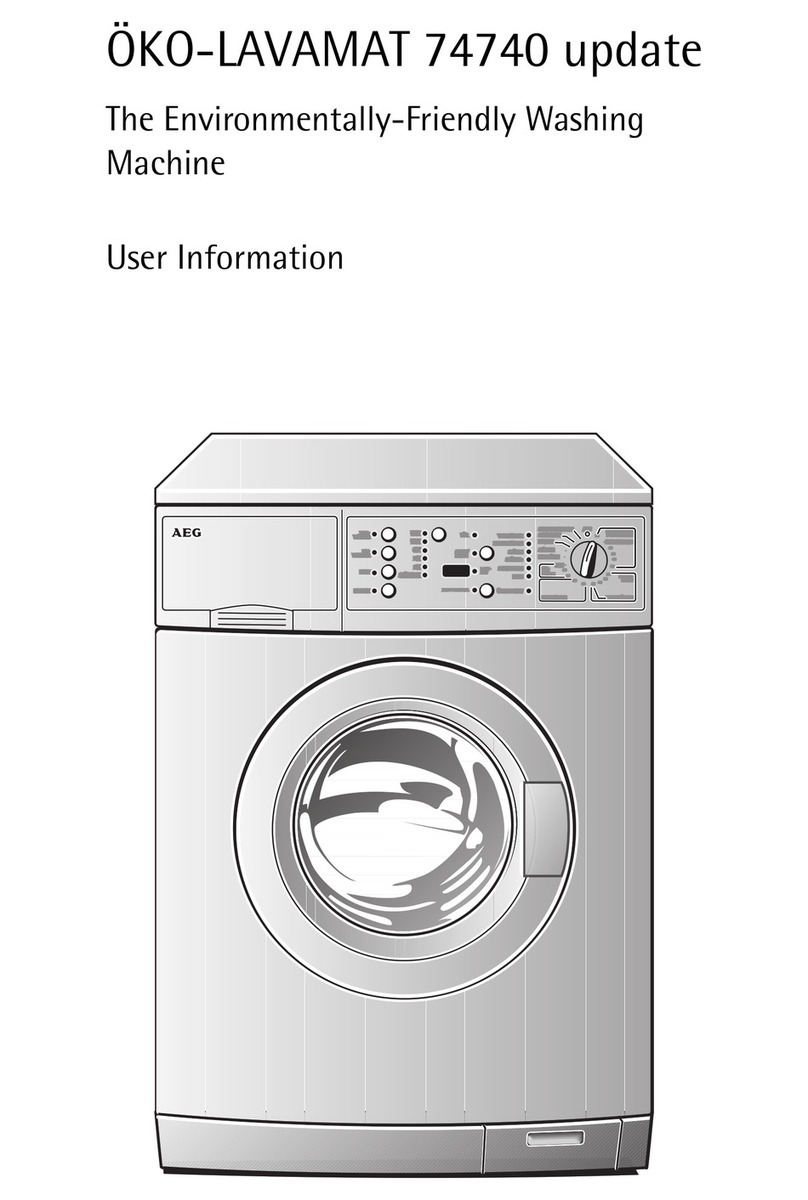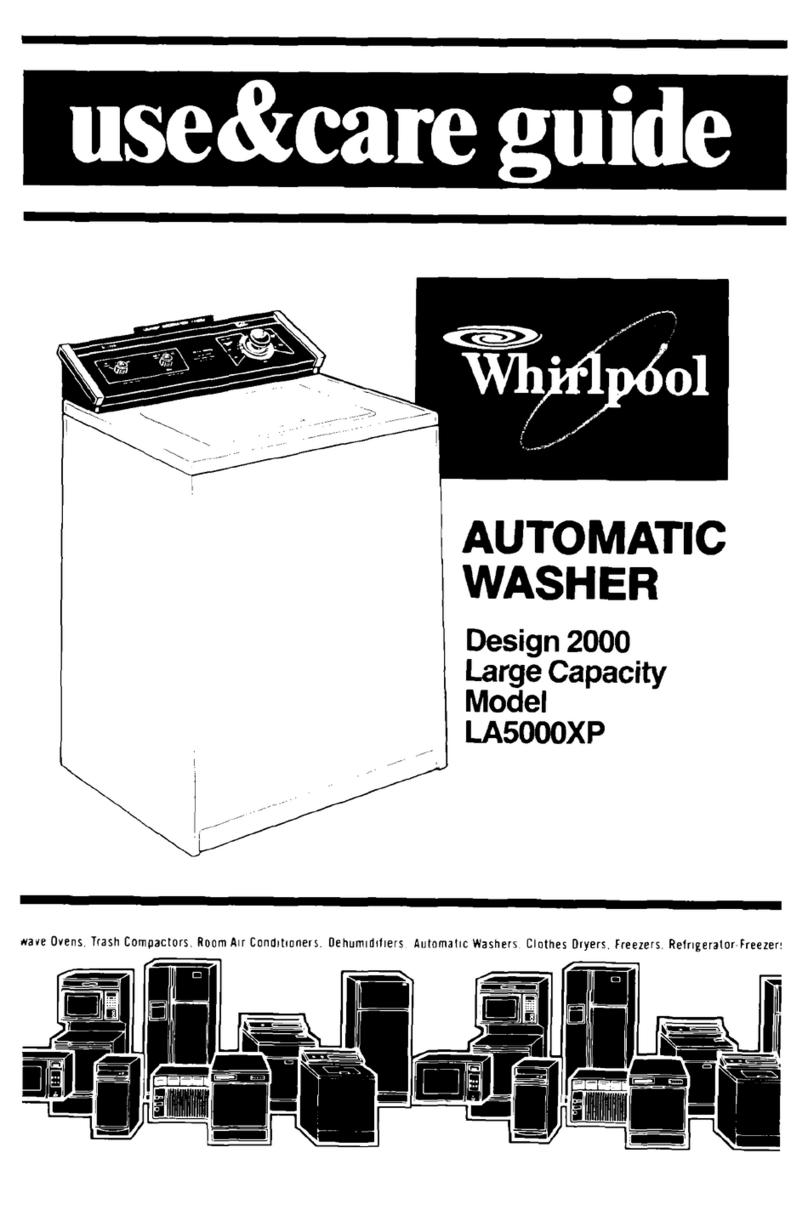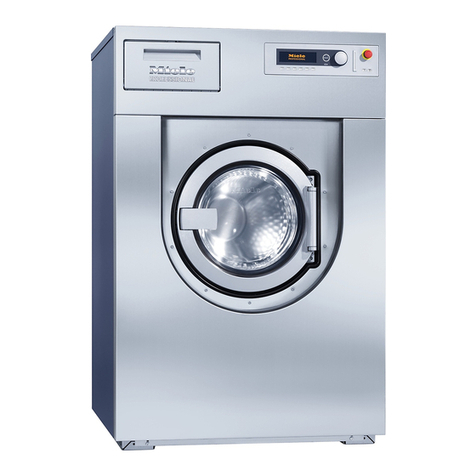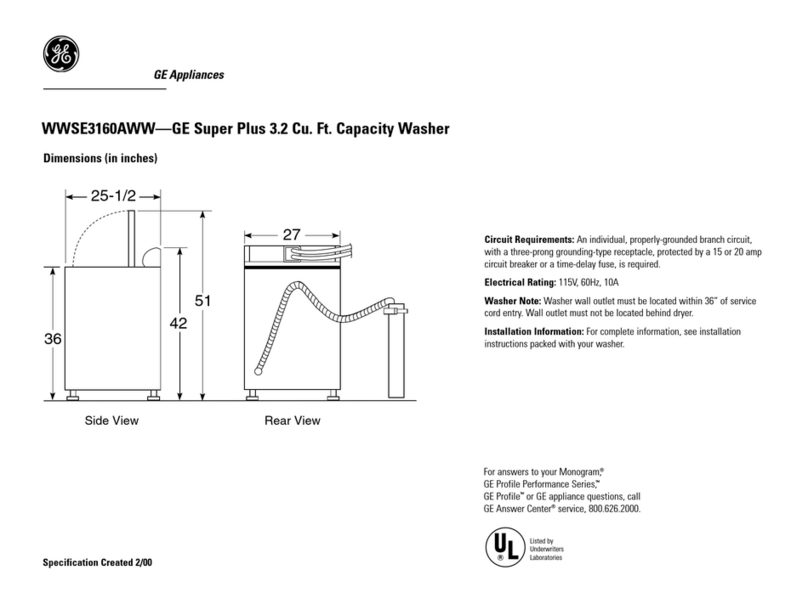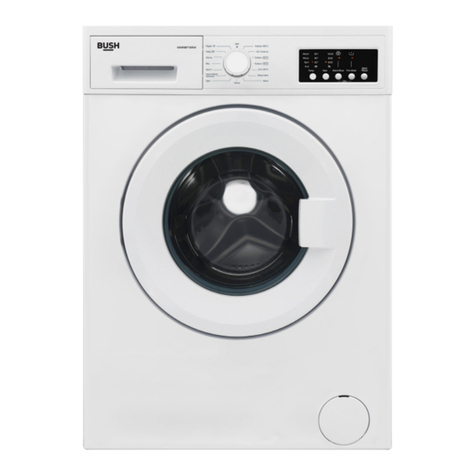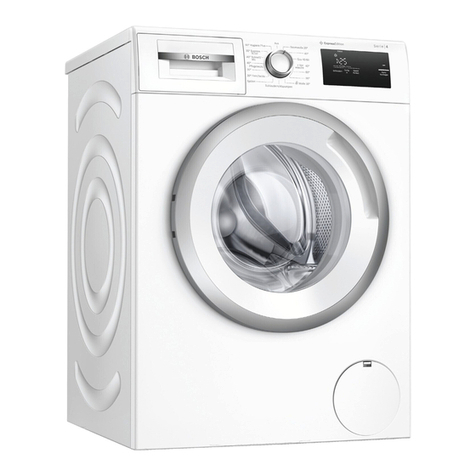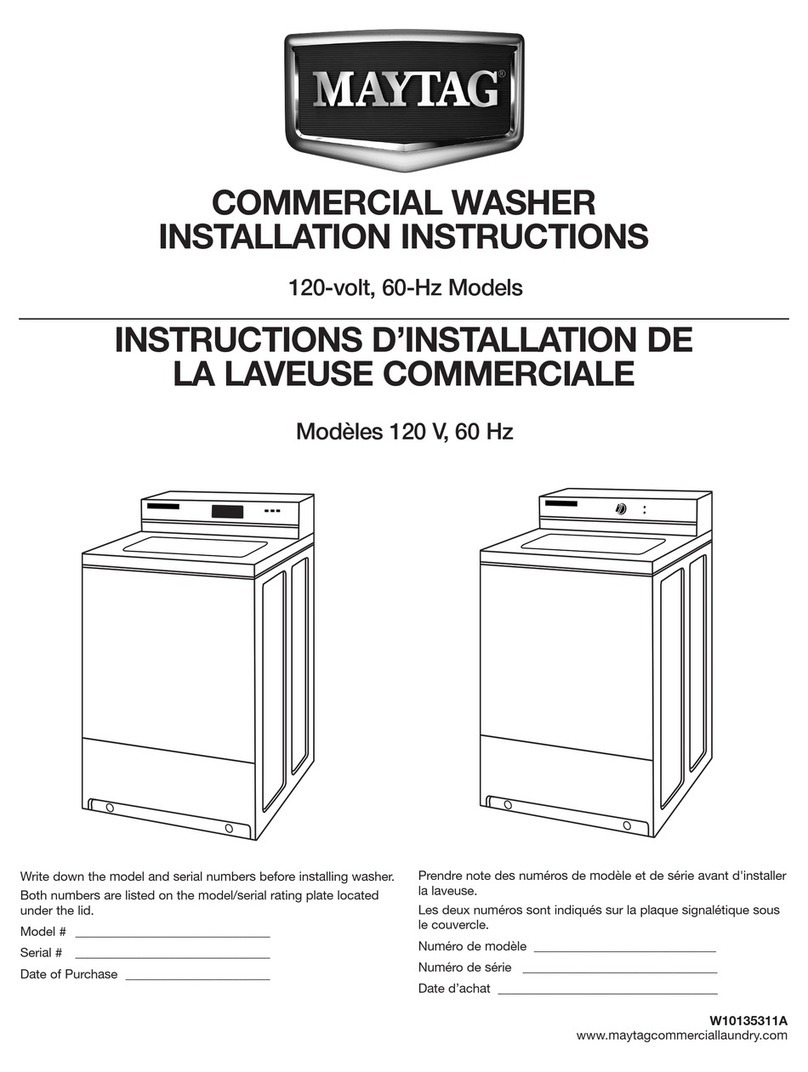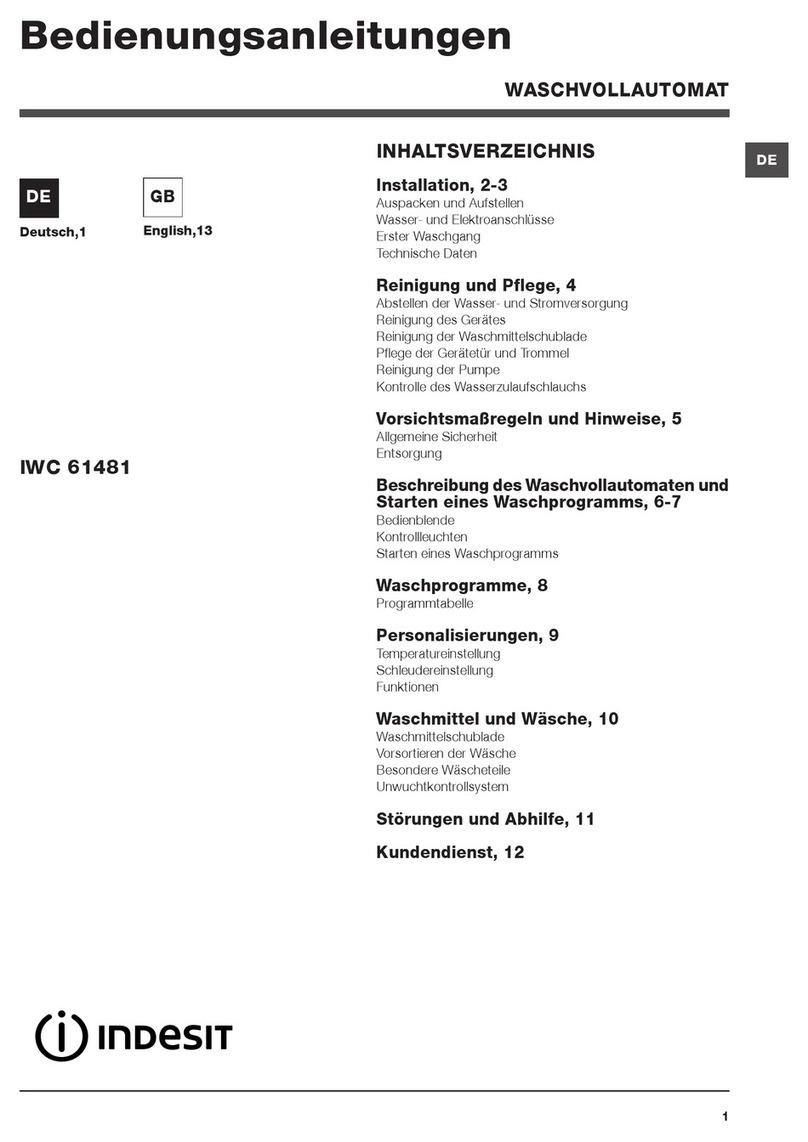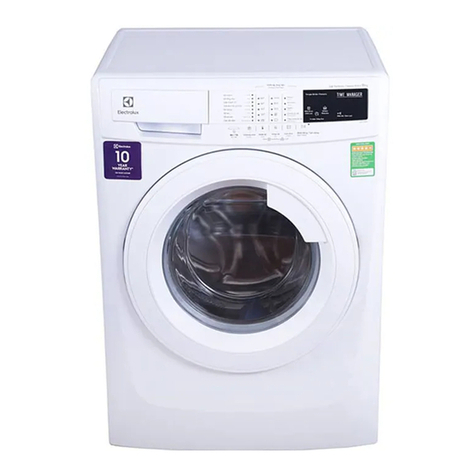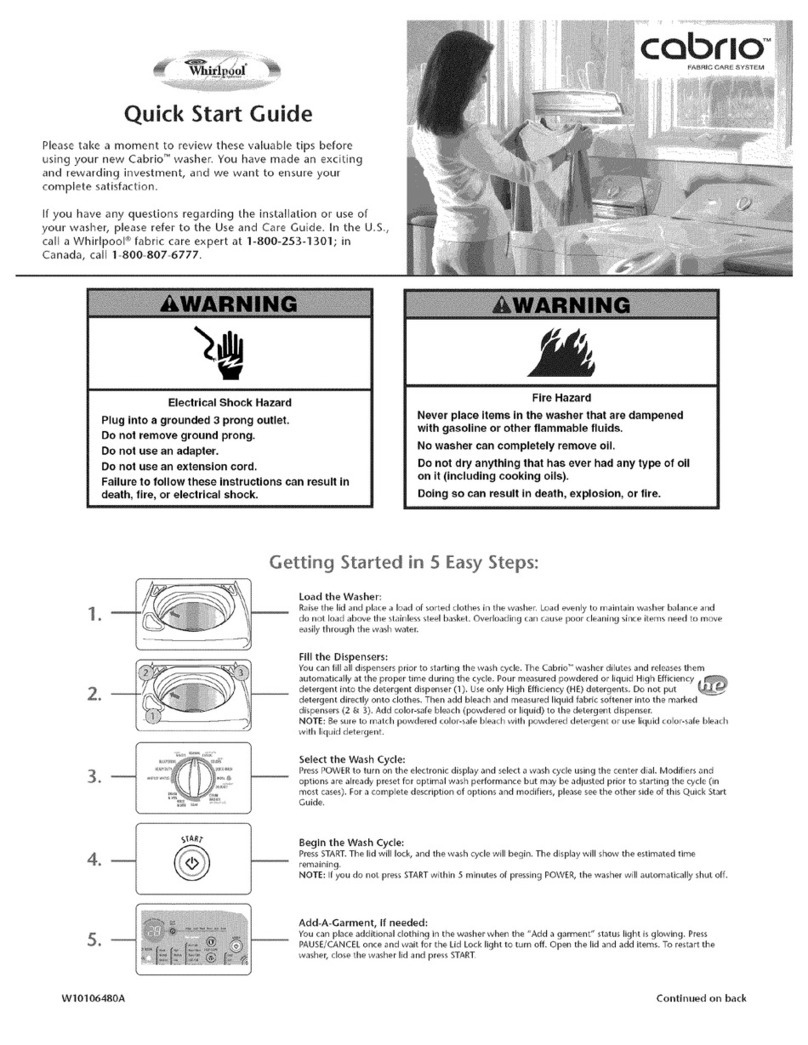Beko WMB 61221 PTM User manual

2820522664_EN/080915.1719
Document Number=
Washing Machine
User’s Manual
WMB 61221 PTM
WMB 60821 M
EN BG

This product was manufactured using the latest technology in environmentally friendly conditions.

3
EN
1 Important safety instructions
This section contains safety instructions that will help protect
from risk of personal injury or property damage. Failure to
follow these instructions shall void any warranty.
General safety
• 8 years and older children and people with reduced
physical, sensory, and mental abilities as well as
unskilled or inexperienced persons can use this
appliance provided that they are supervised and
instructed on safe use of the appliance as well as to the
related dangers. Children should not play or tamper with
the appliance. Cleaning and user maintenance should
never be performed by children unless supervised by a
responsible adult.
• Never place the product on a carpet-covered floor;
otherwise, lack of airflow beneath the machine will
cause electrical parts to overheat. This will cause
problems with your product.
• Do not operate the product if the power cable / plug is
damaged. Call the Authorized Service Agent.
• Have a qualified electrician connect a 16-Ampere fuse
to the installation location of the product.
• If the product has a failure, it should not be operated
unless it is repaired by the Authorized Service Agent.
There is the risk of electric shock!
• This product is designed to resume operating in the
event of powering on after a power interruption. If you
wish to cancel the programme, see "Cancelling the
programme" section.
• Connect the product to a grounded outlet protected
by a fuse complying with the values in the "Technical
specifications" table. Do not neglect to have the
grounding installation made by a qualified electrician.
Our company shall not be liable for any damages that
will arise when the product is used without grounding in
accordance with the local regulations.
• The water supply and draining hoses must be securely
fastened and remain undamaged. Otherwise, there is
the risk of water leakage.
• Never open the loading door or remove the filter while
there is still water in the drum. Otherwise, risk of
flooding and injury from hot water will occur.
• Do not force open the locked loading door. The loading
door will be ready to open just a few minutes after the
washing cycle comes to an end. In case of forcing the
loading door to open, the door and the lock mechanism
may get damaged.
• Unplug the product when not in use.
• Never wash the product by spreading or pouring water
onto it! There is the risk of electric shock!
• Never touch the plug with wet hands! Never unplug by
pulling on the cable, always pull out by grabbing the
plug.
• Use detergents, softeners and supplements suitable for
automatic washing machines only.
• Follow the instructions on the textile tags and on the
detergent package.
• The product must be unplugged during installation,
maintenance, cleaning and repairing procedures.
• Always have the installation and repairing procedures
carried out by the Authorized Service Agent.
Manufacturer shall not be held liable for damages that
may arise from procedures carried out by unauthorized
persons.
Intended use
• This product has been designed for domestic use. It is
not suitable for commercial use and it must not be used
out of its intended use.
• The product must only be used for washing and rinsing
of laundry that are marked accordingly.
• The manufacturer waives any responsibility arisen from
incorrect usage or transportation.
Children's safety
• Electrical products are dangerous for the children. Keep
children away from the product when it is in use. Do not
let them to tamper with the product. Use child lock to
prevent children from intervening with the product.
• Do not forget to close the loading door when leaving the
room where the product is located.
• Store all detergents and additives in a safe place away
from the reach of the children.
2 Installation
Refer to the nearest Authorised Service Agent for installation
of the product. To make the product ready for use, review
the information in the user manual and make sure that the
electricity, tap water supply and water drainage systems are
appropriate before calling the Authorized Service Agent. If they
are not, call a qualified technician and plumber to have any
necessary arrangements carried out.
CPreparation of the location and electrical, tap water and
waste water installations at the place of installation is
under customer's responsibility.
BInstallation and electrical connections of the product
must be carried out by the Authorized Service Agent.
Manufacturer shall not be held liable for damages that
may arise from procedures carried out by unauthorized
persons.
APrior to installation, visually check if the product has any
defects on it. If so, do not have it installed. Damaged
products cause risks for your safety.
CMake sure that the water inlet and discharge hoses
as well as the power cable are not folded, pinched or
crushed while pushing the product into its place after
installation or cleaning procedures.
Appropriate installation location
• Place the machine on a rigid floor. Do not place it on a
long pile rug or similar surfaces.
• Total weight of the washing machine and the dryer -with
full load- when they are placed on top of each other
reaches to approx. 180 kilograms. Place the product
on a solid and flat floor that has sufficient load carrying
capacity!
• Do not place the product on the power cable.
• Do not install the product at places where temperature
may fall below 0ºC.
• Place the product at least 1 cm away from the edges of
other furniture.

4
EN
Removing packaging reinforcement
Tilt the machine backwards to remove the packaging
reinforcement. Remove the packaging reinforcement by
pulling the ribbon.
Removing the transportation locks
ADo not remove the transportation locks before taking
out the packaging reinforcement.
ARemove the transportation safety bolts before operating
the washing machine, otherwise, the product will be
damaged.
1. Loosen all the bolts with a spanner until they rotate
freely (C).
2. Remove transportation safety bolts by turning them
gently.
3. Attach the plastic covers supplied in the User Manual
bag into the holes on the rear panel. (P)
CKeep the transportation safety bolts in a safe place to
reuse when the washing machine needs to be moved
again in the future.
CNever move the product without the transportation
safety bolts properly fixed in place!
Connecting water supply
CThe water supply pressure required to run the product
is between 1 to 10 bars (0.1 – 1 MPa). It is necessary
to have 10 – 80 liters of water flowing from the fully
open tap in one minute to have your machine run
smoothly. Attach a pressure reducing valve if water
pressure is higher.
CIf you are going to use the double water-inlet product
as a single (cold) water-inlet unit, you must install the
supplied stopper to the hot water valve before operating
the product. (Applies for the products supplied with a
blind stopper group.)
CIf you want to use both water inlets of the product,
connect the hot water hose after removing the stopper
and gasket group from the hot water valve. (Applies for
the products supplied with a blind stopper group.)
AModels with a single water inlet should not be
connected to the hot water tap. In such a case the
laundry will get damaged or the product will switch to
protection mode and will not operate.
ADo not use old or used water inlet hoses on the new
product. It may cause stains on your laundry.
1. Connect the special hoses supplied with the product to
the water inlets on the product. Red hose (left) (max. 90
ºC) is for hot water inlet, blue hose (right) (max. 25 ºC) is
for cold water inlet.
AEnsure that the cold and hot water connections are
made correctly when installing the product. Otherwise,
your laundry will come out hot at the end of the washing
process and wear out.
2. Tighten all hose nuts by hand. Never use a wrench
when tightening the nuts.
3. Open the taps completely after making the hose
connection to check for water leaks at the connection
points. If any leaks occur, turn off the tap and remove
the nut. Retighten the nut carefully after checking the
seal. To prevent water leakages and damages caused
by them, keep the taps closed when the machine is not
in use.
Connecting to the drain
• The end of the drain hose must be directly connected to
the wastewater drain or to the washbasin.
AYour house will be flooded if the hose comes out of
its housing during water discharge. Moreover, there is
risk of scalding due to high washing temperatures! To
prevent such situations and to ensure smooth water
intake and discharge of the machine, fix the end of the
discharge hose tightly so that it cannot come out.
• The hose should be attached to a height of at least 40
cm, and 100 cm at most.
• In case the hose is elevated after laying it on the floor
level or close to the ground (less than 40 cm above the
ground), water discharge becomes more difficult and
the laundry may come out excessively wet. Therefore,
follow the heights described in the figure.
100cm
40cm

5
EN
• To prevent flowing of dirty water back into the machine
and to allow for easy discharge, do not immerse the
hose end into the dirty water or drive it in the drain
more than 15 cm. If it is too long, cut it short.
• The end of the hose should not be bent, it should not be
stepped on and the hose must not be pinched between
the drain and the machine.
• If the length of the hose is too short, use it by adding
an original extension hose. Length of the hose may
not be longer than 3.2 m. To avoid water leak failures,
the connection between the extension hose and the
drain hose of the product must be fitted well with an
appropriate clamp as not to come off and leak.
Adjusting the feet
AIn order to ensure that the product operates more silent
and vibration-free, it must stand level and balanced on
its feet. Balance the machine by adjusting the feet.
Otherwise, the product may move from its place and
cause crushing and vibration problems.
1. Loosen the lock nuts on the feet by hand.
2. Adjust the feet until the product stands level and
balanced.
3. Tighten all lock nuts again by hand.
ADo not use any tools to loosen the lock nuts. Otherwise,
they will get damaged.
Electrical connection
Connect the product to a grounded outlet protected by a fuse
complying with the values in the "Technical specifications"
table. Our company shall not be liable for any damages that
will arise when the product is used without grounding in
accordance with the local regulations.
• Connection must comply with national regulations.
• Power cable plug must be within easy reach after
installation.
• The voltage and allowed fuse or breaker protection are
specified in the “Technical specifications” section. If the
current value of the fuse or breaker in the house is less
than 16 Amps, have a qualified electrician install a 16
Amp fuse.
• The specified voltage must be equal to your mains
voltage.
• Do not make connections via extension cables or multi-
plugs.
BDamaged power cables must be replaced by the
Authorized Service Agents.
First use
Before starting to use the product, make sure that all
preparations are made in accordance with the instructions in
sections "Important safety instructions" and "Installation".
To prepare the product for washing laundry, perform first
operation in Drum Cleaning programme. If your machine is
not featured with Drum Cleaning programme, use Cottons-90
programme and select Additional Water or Extra Rinse
auxiliary functions as well. Before starting the programme,
put max. 100 g of powder anti-limescale into the main
wash detergent compartment (compartment nr. II). If the
anti-limescale is in tablet form, put only one tablet into
compartment nr. II. Dry the inside of the bellow with a clean
piece of cloth after the programme has come to an end.
CUse an anti-limescale suitable for the washing
machines.
CSome water might have remained in the product due to
the quality control processes in the production. It is not
harmful for the product.
Disposing of packaging material
Packaging materials are dangerous to children. Keep
packaging materials in a safe place away from reach of the
children.
Packaging materials of the product are manufactured from
recyclable materials. Dispose of them properly and sort in
accordance with recycled waste instructions. Do not dispose
of them with normal domestic waste.
Transportation of the product
Unplug the product before transporting it. Remove water drain
and water supply connections. Drain the remaining water in
the product completely; see, "Draining remaining water and
cleaning the pump filter". Install transportation safety bolts in
the reverse order of removal procedure; see, "Removing the
transportation locks".

6
EN
CNever move the product without the transportation
safety bolts properly fixed in place!
Disposing of the old product
Dispose of the old product in an environmentally friendly
manner.
Refer to your local dealer or solid waste collection centre in
your area to learn how to dispose of your product.
For children's safety, cut the power cable and break the
locking mechanism of the loading door so that it will be
nonfunctional before disposing of the product.
instructions on the package.
• Wash trousers and delicate laundry turned inside out.
• Keep laundry items made of Angora wool in the freezer
for a few hours before washing. This will reduce pilling.
• Laundry that are subjected to materials such as flour,
lime dust, milk powder, etc. intensely must be shaken
off before placing into the machine. Such dusts and
powders on the laundry may build up on the inner parts
of the machine in time and can cause damage.
Correct load capacity
The maximum load capacity depends on the type of laundry,
the degree of soiling and the washing programme desired.
The machine automatically adjusts the amount of water
according to the weight of the loaded laundry.
AFollow the information in the “Programme and
consumption table”. When overloaded, machine's
washing performance will drop. Moreover, noise and
vibration problems may occur.
Loading the laundry
• Open the loading door.
• Place laundry items loosely into the machine.
• Push the loading door to close until you hear a locking
sound. Ensure that no items are caught in the door.
CThe loading door is locked while a programme is
running. The door can only be opened a while after the
programme comes to an end.
AIn case of misplacing the laundry, noise and vibration
problems may occur in the machine.
Using detergent and softener
Detergent Drawer
The detergent drawer is composed of three compartments:
- (1) for prewash
- (2) for main wash
– (3) for softener
– (*) in addition, there is siphon piece in the softener
compartment.
1
23
Detergent, softener and other cleaning agents
• Add detergent and softener before starting the washing
programme.
• Never open the detergent drawer while the washing
programme is running!
• When using a programme without prewash, do not
put any detergent into the prewash compartment
(compartment nr. I).
• In a programme with prewash, do not put liquid
detergent into the prewash compartment (compartment
nr. I).
• Do not select a programme with prewash if you are
using a detergent bag or dispensing ball. Place the
detergent bag or the dispensing ball directly among the
3 Preparation
Things to be done for energy saving
Following information will help you use the product in an
ecological and energy-efficient manner.
• Operate the product in the highest capacity allowed by
the programme you have selected, but do not overload;
see, "Programme and consumption table".
• Always follow the instructions on the detergent
packaging.
• Wash slightly soiled laundry at low temperatures.
• Use faster programmes for small quantities of lightly
soiled laundry.
• Do not use prewash and high temperatures for laundry
that is not heavily soiled or stained.
• If you plan to dry your laundry in a dryer, select the
highest spin speed recommended during washing
process.
• Do not use detergent in excess of the amount
recommended on the detergent package.
Sorting the laundry
• Sort laundry according to type of fabric, colour, and
degree of soiling and allowable water temperature.
• Always obey the instructions given on the garment tags.
Preparing laundry for washing
• Laundry items with metal attachments such as,
underwired bras, belt buckles or metal buttons will
damage the machine. Remove the metal pieces or wash
the clothes by putting them in a laundry bag or pillow
case.
• Take out all substances in the pockets such as coins,
pens and paper clips, and turn pockets inside out and
brush. Such objects may damage the product or cause
noise problem.
• Put small size clothes such as infant's socks and nylon
stockings in a laundry bag or pillow case.
• Place curtains in without compressing them. Remove
curtain attachment items.
• Fasten zippers, sew loose buttons and mend rips and
tears.
• Wash “machine washable” or “hand washable” labeled
products only with an appropriate programme.
• Do not wash colours and whites together. New, dark
coloured cottons release a lot of dye. Wash them
separately.
• Tough stains must be treated properly before washing. If
unsure, check with a dry cleaner.
• Use only dyes/colour changers and limescale
removers suitable for machine wash. Always follow the

7
EN
laundry in the machine.
• If you are using liquid detergent, do not forget to
place the liquid detergent cup into the main wash
compartment (compartment nr. II).
Choosing the detergent type
The type of detergent to be used depends on the type and
colour of the fabric.
• Use different detergents for coloured and white laundry.
• Wash your delicate clothes only with special detergents
(liquid detergent, wool shampoo, etc.) used solely for
delicate clothes.
• When washing dark coloured clothes and quilts, it is
recommended to use liquid detergent.
• Wash woolens with special detergent made specifically
for woolens.
AUse only detergents manufactured specifically for
washing machines.
ADo not use soap powder.
Adjusting detergent amount
The amount of washing detergent to be used depends on the
amount of laundry, the degree of soiling and water hardness.
Read the manufacturer's instructions on the detergent
package carefully and follow the dosage values.
• Do not use amounts exceeding the dosage quantities
recommended on the detergent package to avoid
problems of excessive foam, poor rinsing, financial
savings and finally, environmental protection.
• Use lesser detergent for small amounts or lightly soiled
clothes.
• Use concentrated detergents in the recommended
dosage.
Using softeners
Pour the softener into the softener compartment of the
detergent drawer.
• Use the dosages recommended on the package.
• Do not exceed the (>max<) level marking in the softener
compartment.
• If the softener has lost its fluidity, dilute it with water
before putting it in the detergent drawer.
Using liquid detergents
If the product contains a liquid detergent cup:
• Make sure that you have placed the liquid detergent cup
in compartment nr. “2”.
• Use the detergent manufacturer's measuring cup and
follow the instructions on the package.
• Use the dosages recommended on the package.
• If the liquid detergent has lost its fluidity, dilute it with
water before putting in the detergent cup.
If the product does not contain a liquid detergent cup:
• Do not use liquid detergent for the prewash in a
programme with prewash.
• Use the detergent manufacturer's measuring cup and
follow the instructions on the package.
• Liquid detergent stains your clothes when used with
Delayed Start function. If you are going to use the
Delayed Start function, do not use liquid detergent.
Using gel and tablet detergent
When using tablet, gel, etc. detergents, read the
manufacturer's instructions on the detergent package
carefully and follow the dosage values. If there is not any
instruction on the package, apply the following.
• If the gel detergent thickness is fluidal and your
machine does not contain a special liquid detergent
cup, put the gel detergent into the main wash detergent
compartment during first water intake. If your machine
contains a liquid detergent cup, fill the detergent into
this cup before starting the programme.
• If the gel detergent thickness is not fluidal or in the
shape of capsule liquid tablet, put it directly into the
drum before washing.
• Put tablet detergents into the main wash compartment
(compartment nr. II) or directly into the drum before
washing.
CTablet detergents may leave residues in the detergent
compartment. If you encounter such a case, place the
tablet detergent between the laundry, close to the lower
part of the drum in future washings.
CUse the tablet or gel detergent without selecting the
prewash function.
Using starch
• Add liquid starch, powder starch or the dyestuff into the
softener compartment as instructed on the package.
• Do not use softener and starch together in a washing
cycle.
• Wipe the inside of the machine with a damp and clean
cloth after using starch.
Using bleaches
• Select a programme with prewash and add the
bleaching agent at the beginning of the prewash. Do
not put detergent in the prewash compartment. As an
alternative application, select a programme with extra
rinse and add the bleaching agent while the machine
is taking water from the detergent compartment during
first rinsing step.
• Do not use bleaching agent and detergent by mixing
them.
• Use just a little amount (approx. 50 ml) of bleaching
agent and rinse the clothes very well as it causes skin
irritation. Do not pour the bleaching agent onto the
clothes and do not use it for coloured clothes.
• When using oxygen based bleaches, follow the
instructions on the package and select a programme
that washes at a lower temperature.
• Oxygen based bleaches can be used together with
detergents; however, if its thickness is not the same
with the detergent, put the detergent first into the
compartment nr. “2” in the detergent drawer and wait

8
EN
until the detergent flows while the machine is taking in water. Add the bleaching agent from the same compartment
while the machine is still taking in water.
Using limescale remover
• When required, use limescale removers manufactured specifically for washing machines only.
• Always follow instructions on the package.
Tips for efficient washing
Clothes
Light colours and whites Colors Dark colors Delicates/Woolens/
Silks
(Recommended temperature
range based on soiling level:
40-90C)
(Recommended temperature
range based on soiling level:
cold-40C)
(Recommended
temperature range
based on soiling level:
cold-40C)
(Recommended
temperature range
based on soiling level:
cold-30C)
Soiling Level
Heavily Soiled
(difficult stains such
as grass, coffee, fruits
and blood.)
It may be necessary to pre-
treat the stains of perform
prewash. Powder and liquid
detergents recommended
for whites can be used at
dosages recommended for
heavily soiled clothes. It is
recommended to use powder
detergents to clean clay and
soil stains and the stains that
are sensitive to bleaches.
Powder and liquid detergents
recommended for colours
can be used at dosages
recommended for heavily soiled
clothes. It is recommended
to use powder detergents to
clean clay and soil stains and
the stains that are sensitive
to bleaches. Use detergents
without bleach.
Liquid detergents
suitable for colours
and dark colours can
be used at dosages
recommended for
heavily soiled clothes.
Prefer liquid detergents
produced for delicate
clothes. Woollen and
silk clothes must be
washed with special
woollen detergents.
Normally Soiled
(For example, stains
caused by body on
collars and cuffs)
Powder and liquid detergents
recommended for whites
can be used at dosages
recommended for normally
soiled clothes.
Powder and liquid detergents
recommended for colours
can be used at dosages
recommended for normally
soiled clothes. Use detergents
without bleach.
Liquid detergents
suitable for colours
and dark colours can
be used at dosages
recommended for
normally soiled clothes.
Prefer liquid detergents
produced for delicate
clothes. Woollen and
silk clothes must be
washed with special
woollen detergents.
Lightly Soiled
(No visible stains
exist.)
Powder and liquid detergents
recommended for whites
can be used at dosages
recommended for lightly
soiled clothes.
Powder and liquid detergents
recommended for colours
can be used at dosages
recommended for lightly soiled
clothes. Use detergents without
bleach.
Liquid detergents
suitable for colours
and dark colours can
be used at dosages
recommended for lightly
soiled clothes.
Prefer liquid detergents
produced for delicate
clothes. Woollen and
silk clothes must be
washed with special
woollen detergents.

9
EN
4 Operating the product
Control panel
1 - Programme Selection knob (Uppermost position On/Off)
2 - Programme Follow-up indicator
3 - Temperature Adjustment button
4 - Spin Speed adjustment button
5 - Auxiliary Function buttons
6 - Delayed Start button (in some models)
7 - Start / Pause button
Preparing the machine
Make sure that the hoses are connected tightly. Plug in your
machine. Turn the tap on completely. Place the laundry in the
machine. Add detergent and fabric softener.
Programme selection
1. Select the programme suitable for the type, quantity
and soiling degree of the laundry in accordance with
the "Programme and consumption table" and the
temperature table below.
90˚C Heavily soiled white cottons and linens.
(coffee table covers, tableclothes, towels, bed
sheets, etc.)
60˚C
Normally soiled, coloured, fade proof cottons
or synthetic clothes (shirt, nightgown,
pajamas, etc.) and lightly soiled white linens
(underwear, etc.)
40˚C-
30˚C- Cold
Blended laundry including delicate textile (veil
curtains, etc.), synthetics and woolens.
2. Select the desired programme with the Programme
Selection button.
CProgrammes are limited with the highest spin speed
appropriate for that particular type of fabric.
CWhen selecting a programme, always consider the type
of fabric, colour, degree of soiling and permissible water
temperature.
CAlways select the lowest required temperature. Higher
temperature means higher power consumption.
CFor further programme details, see "Programme and
consumption table".
Main programmes
Depending on the type of fabric, use the following main
programmes.
• Cottons
Use this programme for your cotton laundry (such as bed
sheets, duvet and pillowcase sets, towels, bathrobes,
underwear, etc.). Your laundry will be washed with vigorous
washing action for a longer washing cycle.
• Synthetics
Use this programme to wash your synthetic clothes (shirts,
blouses, synthetic/cotton blends, etc.). It washes with a gentle
action and has a shorter washing cycle compared to the
Cottons programme.
For curtains and tulle, use the Synthetic 40˚C programme
with prewash and anti-creasing functions selected. As their
meshed texture causes excessive foaming, wash the veils/
tulle by putting little amount of detergent into the main
wash compartment. Do not put detergent in the prewash
compartment.
• Woollens
Use this programme to wash your woolen clothes. Select
the appropriate temperature complying with the tags of your
clothes. Use appropriate detergents for woolens.
Additional programmes
For special cases, additional programmes are available in the
machine.
CAdditional programmes may differ according to the
model of the machine.
• Cotton Economic
You may wash your normally soiled durable cotton and
linen laundry in this programme with the highest energy
1 2
76543

10
EN
and water saving compared to all other wash programmes
suitable for cottons. Actual water temperature may differ
from the declared cycle temperature. Programme duration
may automatically be shortened during later stages of the
programme if you wash less amount (e.g. ½ capacity or less)
of laundry. In this case energy and water consumption will
be further decreased giving you the opportunity for a more
economical wash. This feature is available for certain models
having remaining time display.
• BabyProtect
Use this programme for baby clothes and clothes worn by
allergic people. Increased hygiene is provided by a longer
heating period and an additional rinse cycle.
• Hand wash
Use this programme to wash your woolen/delicate clothes
that bear “not machine- washable” tags and for which hand
wash is recommended. It washes laundry with a very gentle
washing action to not to damage clothes.
• Daily express
Use this programme to quickly wash your lightly soiled cotton
clothes.
• Darkwash
Use this programme to wash your dark coloured laundry, or
the coloured laundry that you do not want them get faded.
Washing is performed with less mechanical movements at
low temperature. It is recommended to use liquid detergent or
wool shampoo for dark coloured laundry.
• Mixed 40 (Mix 40)
Use this programme to wash your cotton and synthetic clothes
together without sorting them.
Special programmes
For specific applications, select any of the following
programmes.
• Rinse
Use this programme when you want to rinse or starch
separately.
• Spin + Drain
Use this programme to apply an additional spin cycle for your
laundry or to drain the water in the machine.
Before selecting this programme, select the desired spin
speed and press Start / Pause button. First, the machine will
drain the water inside of it. Then, it will spin the laundry with
the set spin speed and drain the water coming out of them.
If you wish to drain only the water without spinning your
laundry, select the Pump+Spin programme and then select
the No Spin function with the help of Spin Speed Adjustment
button. Press Start / Pause button.
CUse a lower spin speed for delicate laundries.
Temperature selection
Whenever a new programme is selected, the recommended
temperature for the selected programme appears on the
temperature indicator.
To decrease the temperature, press the Temperature
Adjustment button. Temperature will decrease gradually.
CIf the programme has not reached the heating step,
you can change the temperature without switching the
machine to Pause mode.
Spin speed selection
Whenever a new programme is selected, the recommended
spin speed of the selected programme is displayed on the
spin speed indicator.
To decrease the spin speed, press the Spin Speed Adjustment
button. Spin speed decreases gradually. Then, depending on
the model of the product, "Rinse Hold" and "No Spin" options
appear on the display. See "Auxiliary function selection"
section for explanations of these options.
CIf the programme has not reached the spinning step, you
can change the speed without switching the machine to
Pause mode.

11
EN
Programme and consumption table
• Selectable
* Automatically selected, no canceling.
** Energy Label programme (EN 60456 Ed.3)
*** If maximum spin speed of the machine is lower then this value, you can only select up to the maximum spin speed.
CWater and power consumption may vary subject to the changes in water pressure, water hardness and temperature,
ambient temperature, type and amount of laundry, selection of auxiliary functions and spin speed, and changes in electric
voltage.
CYou can see the washing time of the programme you have selected on the display of the machine. It is normal that small
differences may occur between the time shown on the display and the real washing time.
CThe auxiliary functions in the table may vary according to the model of your machine.
EN 2Auxiliary functions
Programme
Max. Load (kg)
Programme Duration (~min)
Water Consumption (l)
Energy Consumption (kWh)
Max. Speed***
Prewash
Quick Wash
Rinse Plus
Anti-Creasing
Rinse Hold
Pet hair removal
Selectable
temperature range °C
Cottons 90 6150 65 2.00 1600 •••••• Cold-90
Cottons 60 6122 65 1.35 1600 •••••• Cold-90
Cottons 40 6102 65 0.70 1600 •••••• Cold-90
Cotton Economic 60** 6160 44 1.01 1600 •40-60
Cotton Economic 60** 3130 37 0.82 1600 •40-60
Cotton Economic 40** 3130 37 0.64 1600 •40-60
Daily express 90 688 47 1.70 1400 • • Cold-90
Daily express 60 658 60 1.00 1400 • • Cold-90
Daily express 30 628 55 0.20 1400 • • Cold-90
Darkwash 40 2.5 107 58 0.45 800 * • Cold-40
Mixed 40 (Mix 40) 40 3115 45 0.50 800 •••••• Cold-40
Hand wash 30 143 30 0.15 600 Cold-30
Woollens 40 1.5 60 40 0.30 600 • • Cold-40
BabyProtect 90 6165 82 2.00 1600 •*• 30-90
Synthetics 60 2.5 116 45 0.90 800 •••••• Cold-60
Synthetics 40 2.5 106 45 0.42 800 •••••• Cold-60
** “Cotton eco 40°C and Cotton eco 60°C are the standard programmes.” These programmes are referred to as ‘standard 40°C
cotton programme’ and ‘standard 60°C cotton programme’

12
EN
Auxiliary function selection
Use the following auxiliary functions according to your daily
needs. Select the desired auxiliary functions before starting
the programme. Furthermore, you may also select or cancel
auxiliary functions that are suitable to the running programme
without pressing the Start / Pause button when the machine
is operating. For this, the machine must be in a step before
the auxiliary function you are going to select or cancel.
If the auxiliary function cannot be selected or canceled, light
of the relevant auxiliary function will blink 3 times to warn the
user.
CSome functions cannot be selected together. For
example, Prewash and Quick Wash.
CIf a second auxiliary function conflicting with the first
one is selected before starting the machine, the function
selected first will be canceled and the second auxiliary
function selection will remain active. For example, if you
want to select Quick Wash after you have selected the
Prewash, Prewash will be canceled and Quick Wash will
remain active.
CAn auxiliary function that is not compatible with the
programme cannot be selected. (See "Programme and
consumption table")
CAuxiliary Function buttons may vary according to the
model of the machine.
• Prewash
A Prewash is only worthwhile for heavily soiled laundry. Not
using the Prewash will save energy, water, detergent and
time.
CPrewash without detergent is recommended for tulle
and curtains.
• Quick Wash
This function can be used in Cottons and Synthetics
programmes. It decreases the washing times and also the
number of rinsing steps for lightly soiled laundry.
CWhen you select this function, load your machine
with half of the maximum laundry specified in the
programme table.
• Rinse Plus
This function enables the machine to make another rinsing in
addition to the one already made after the main wash. Thus,
the risk for sensitive skins (babies, allergic skins, etc.) to be
effected by the minimal detergent remnants on the laundry
can be reduced.
• Anti-Creasing
This function creases the clothes lesser when they are being
washed. Drum movement is reduced and spinning speed is
limited to prevent creasing. In addition, washing is done with
a higher water level. Use this function for delicate laundry that
creases easily.
• Rinse Hold
If you are not going to unload your clothes immediately after
the programme completes, you may use rinse hold function
to keep your laundry in the final rinsing water in order to
prevent them from getting wrinkled when there is no water
in the machine. Press Start / Pause button after this process
if you want to drain the water without spinning your laundry.
Programme will resume and complete after draining the
water.
If you want to spin the laundry held in water, adjust the Spin
Speed and press Start / Pause button.
The programme resumes. Water is drained, laundry is spun
and the programme is completed.
• Soaking
The Soaking auxiliary function ensures better removal of
stains ingrained into the clothes by holding them in the
detergent water prior to startup of the programme.
• Pet hair removal
This function removes the pet hairs that remain on your
clothes more effectively.
When this function is selected, Prewash and Extra Rinse
steps are added to the normal programme. Thus, pet hairs
are removed more effectively by performing the washing with
more water (30%).
ANever wash your pets in your washing machine.
Delayed Start (In some models only)
With the Delayed Start function the startup of the programme
may be delayed up to 3, 6 or 9 hours.
CDo not use liquid detergents when you set Delayed
Start! There is the risk of staining of the clothes.
Open the loading door, place the laundry and put detergent,
etc. Select the washing programme, temperature, spin speed
and, if required, the auxiliary functions. Set the desired time
by pressing the Delayed Start button. When the button is
pressed once, 3 hours delayed start is selected. When the
same button is pressed again, 6 hours delay is selected, and
when it is pressed for the third time, 9 hours delayed start is
selected. If you press the Delayed Start button once again,
Delayed Start function will be canceled. Press Start / Pause
button. Previous delayed start time light turns off and next
delayed start time light turns on after every 3 hours. At the
end of the countdown, all delayed start lights will turn off and
the selected programme will start.
CAdditional laundry may be loaded during the delayed
start period.
Changing the Delayed Start period
Press Delayed Start button. Every time the button is pressed,
the period will change in 3-hour increments and the light of
the selected delayed start time will turn on.
Canceling the Delayed Start function
If you want to cancel the delayed start countdown and start
the programme immediately:
Set the Delayed Start period to zero (all delayed start period
lights will turn off) or turn the Programme Selection knob
to any programme. Thus, Delayed Start function will be
canceled. The End/Cancel light flashes continuously. Then,
select the programme you want to run again. Press Start /
Pause button to start the programme.
Starting the programme
Press Start / Pause button to start the programme.
Programme follow-up light showing the startup of the
programme will turn on.
CIf no programme is started or no key is pressed within
1 minute during programme selection process, the
machine will switch to Pause mode and the illumination
level of the temperature, speed and loading door
indicator lights will decrease. Other indicator lights and
indicators will turn off. Once the Programme Selection
knob is rotated or any button is pressed, indicator lights

13
EN
and indicators will turn on again.
Child Lock
Use child lock function to prevent children from tampering
with the machine. Thus you can avoid any changes in a
running programme.
CIf the Programme Selection knob is rotated when the
child lock is active, the lights on the 1st and 2nd auxiliary
function buttons will blink 3 times. The child lock does
not allow any change in the programmes and the
selected temperature, speed and auxiliary functions.
CEven if another programme is selected with the
Programme Selection knob while the Child Lock is
active, previously selected programme will continue
running.
CWhen the Child Lock is active and the machine is
running, you can switch the machine to Pause mode
without deactivating the Child Lock by turning the
Programme Selection knob to On / Off position. When
you turn the Programme Selection knob afterwards, the
programme will resume.
To activate the Child Lock:
Press and hold 1st and 2nd Auxiliary Function buttons for
3 seconds. The lights on the 1st and 2nd Auxiliary Function
buttons will flash while you keep the buttons pressed for 3
seconds.
To deactivate the Child Lock:
Press and hold 1st and 2nd auxiliary function buttons for 3
seconds while any programme is running. The lights on the 1st
and 2nd Auxiliary Function buttons will flash while you keep the
buttons pressed for 3 seconds.
CIn addition to the method above, to deactivate the Child
Lock, switch the Programme Selection knob to On /
Off position when no programme is running, and select
another programme.
CWhen the power is restored after a power failure or after
your machine is unplugged and plugged in again, the
Child Lock will not be deactivated when the machine
resumes operating.
Progress of programme
Progress of a running programme can be followed from the
Programme Follow-up indicator. At the beginning of every
programme step, the relevant indicator light will turn on and
light of the completed step will turn off.
You can change the auxiliary functions, speed and
temperature settings without stopping the programme flow
while the programme is running. To do this, the change
you are going to make must be in a step after the running
programme step. If the change is not compatible, relevant
lights will flash for 3 times.
CIf the machine does not pass to the spinning step,
Rinse Hold function might be active or the automatic
unbalanced load detection system might be activated
due to the unbalanced distribution of the laundry in the
machine.
Loading door lock
There is a locking system on the loading door of the machine
that prevents opening of the door in cases when the water
level is unsuitable.
Loading door light will start flashing when the machine
is switched to Pause mode. Machine checks the level of
the water inside. If the level is suitable, Loading Door light
illuminates steadily within 1-2 minutes and the loading door
can be opened.
If the level is unsuitable, Loading Door light turns off and the
loading door cannot be opened. If you are obliged to open
the Loading Door while the Loading Door light is off, you
have to cancel the current programme; see "Canceling the
programme".
Changing the selections after
programme has started
Switching the machine to pause mode
Press the Start / Pause button to switch the machine to pause
mode while a programme is running. The light of the step
which the machine is in starts flashing in the Programme
Follow-up indicator to show that the machine has been
switched to the pause mode.
Also, when the loading door is ready to be opened, Loading
Door light will also illuminate continuously in addition to the
programme step light.
Changing the speed and temperature settings for
auxiliary functions
Depending on the step the programme has reached, you
may cancel or activate the auxiliary functions; see, "Auxiliary
function selection".
You may also change the speed and temperature settings;
see, "Spin speed selection" and "Temperature selection".
CIf no change is allowed, the relevant light will flash for 3
times.
Adding or taking out laundry
Press the Start / Pause button to switch the machine to pause
mode. The programme follow-up light of the relevant
step during which the machine was switched into the
pause mode will flash.
Wait until the Loading Door can be opened. Open the Loading
Door and add or take out the laundry. Close the Loading Door.
Make changes in auxiliary functions, temperature and speed
settings if necessary. Press Start / Pause button to start the
machine.
Canceling the programme
To cancel the programme, turn the Programme Selection
knob to select another programme. Previous programme will
be canceled. End / Cancel light will flash continuously to notify
that the programme has been canceled.
Your machine will end the programme when you turn the
Programme Selection knob; however, it does not drain the
water inside. When you select and start a new programme,
the newly selected programme will start depending on the
step the previous programme was canceled in. For example,
it may take in additional water or continue to wash with the
water inside.
CDepending on the step where the programme was
canceled in, you may have to put detergent and softener
again for the programme you have selected anew.

14
EN
Close the taps. Remove the nuts of the water intake hoses to
access the filters on the water intake valves. Clean them with
an appropriate brush. If the filters are too dirty, take them
out by means of pliers and clean them. Take out the filters
on the flat ends of the water intake hoses together with the
gaskets and clean thoroughly under running water. Replace
the gaskets and filters carefully in their places and tighten
the hose nuts by hand.
Draining remaining water and
cleaning the pump filter
The filter system in your machine prevents solid items
such as buttons, coins and fabric fibers clogging the pump
impeller during discharge of washing water. Thus, the water
will be discharged without any problem and the service life of
the pump will extend.
If the machine fails to drain water, the pump filter is clogged.
Filter must be cleaned whenever it is clogged or in every 3
months. Water must be drained off first to clean the pump
filter.
In addition, prior to transporting the machine (eg., when
moving to another house) and in case of freezing of the
water, water may have to be drained completely.
AForeign substances left in the pump filter may damage
your machine or may cause noise problem.
In order to clean the dirty filter and discharge the water:
Unplug the machine to cut off the supply power.
ATemperature of the water inside the machine may
rise up to 90 ºC. To avoid burning risk, filter must be
cleaned after the water in the machine cools down.
Open the filter cap.
If the filter cap is composed of two pieces, press the
tab on the filter cap downwards and pull the piece out
towards yourself.
If the filter cap is one piece, pull the cap from both sides at
the top to open.
CYou can remove the filter cover by slightly pushing
downwards with a thin plastic tipped tool, through the
gap above the filter cover. Do not use metal tipped tools
to remove the cover.
Some of our products have emergency draining hose and
some does not have. Follow the steps below to discharge
5 Maintenance and cleaning
Service life of the product extends and frequently faced
problems decrease if cleaned at regular intervals.
Cleaning the detergent drawer
Clean the detergent drawer at regular intervals (every
4-5 washing cycles) as shown below in order to prevent
accumulation of powder detergent in time.
Press the dotted point on the siphon in the softener
compartment and pull towards you until the compartment is
removed from the machine.
CIf more than normal amount of water and softener
mixture starts to gather in the softener compartment,
the siphon must be cleaned.
Wash the detergent drawer and the siphon with plenty of
lukewarm water in a washbasin. Wear protective gloves or
use an appropriate brush to avoid touching of the residues in
the drawer with your skin when cleaning. Insert the drawer
back into its place after cleaning and make sure that it is
seated well.
If your detergent drawer is the one indicated in the following
figure:
CLift the rear part of the siphon to remove it as
illustrated. After performing the above mentioned
cleaning procedures, replace the siphon back to its
seating and push its front section downwards to make
sure that the locking tab engages.
Cleaning the water intake filters
There is a filter at the end of each water intake valve at the
rear of the machine and also at the end of each water intake
hose where they are connected to the tap. These filters
prevent foreign substances and dirt in the water to enter the
washing machine. Filters should be cleaned as they do get
dirty.

15
EN
the water.
Discharging the water when the product has an emergency
draining hose:
Pull the emergency draining hose out from its seat Place
a large container at the end of the hose. Drain the water
into the container by pulling out the plug at the end of the
hose. When the container is full, block the inlet of the hose
by replacing the plug. After the container is emptied, repeat
the above procedure to drain the water in the machine
completely. When draining of water is finished, close the end
by the plug again and fix the hose in its place. Turn the pump
filter to take it out.
Discharging the water when the product does not have an
emergency draining hose:
Place a large container in front of the filter to catch water
from the filter. Loosen pump filter (anticlockwise) until water
starts to flow. Fill the flowing water into the container you
have placed in front of the filter. Always keep a piece of cloth
handy to absorb any spilled water. When the water inside the
machine is finished, take out the filter completely by turning
it. Clean any residues inside the filter as well as fibers, if any,
around the pump impeller region. Install the filter.
AIf your product has a water jet feature, be sure to fit the
filter into its housing in the pump. Never force the filter
while installing it into its housing. Seat the filter into its
place completely. Otherwise, water may leak from the
filter cap.
If the filter cap is composed of two pieces, close the filter cap
by pressing on the tab. If it is one piece, seat the tabs in the
lower part into their places first, and then press the upper
part to close.

16
EN
6 Technical specifications
CTechnical specifications may be changed without prior notice to improve the quality of the product.
CFigures in this manual are schematic and may not match the product exactly.
CValues stated on the product labels or in the documentation accompanying it are obtained in laboratory conditions in
accordance with the relevant standards. Depending on operational and environmental conditions of the product, these
values may vary.
Models (EN)
Maximum dry laundry capacity (kg)
Height (cm)
Width (cm)
Depth (cm)
Net weight (±4 kg.)
Electrical input (V/Hz)
Total current (A)
Total power (W)
Spin speed (rpm max.)
Stand-by mode power (W)
Off-mode power (W)
WMB 61221 PTM WMB 60821 M
6 6
84 84
60 60
45 45
62 59
230 V / 50Hz 230 V / 50Hz
10 10
2200 2200
1200 800
1.35 1.35
0.25 0.25
This appliance’s packaging material is recyclable. Help recycle it and protect the environment by dropping
it off in the municipal receptacles provided for this purpose. Your appliance also contains a great amount
of recyclable material. It is marked with this label to indicate the used appliances that should not be mixed
with other waste. This way, the appliance recycling organised by your manufacturer will be done under
the best possible conditions, in compliance with European Directive 2002/96/EC on Waste Electrical and
Electronic Equipment. Contact your town hall or your retailer for the used appliance collection points closest
to your home. We thank you doing your part to protect the environment.
Dark wash
(Darkcare)
Dark wash
(Darkcare)
Cottons Pre-wash Main
wash
Rinse Wash Spin
Drain
(Pump)
Anti-
creasing
Duvet
(Bedding)
Child-
proof lock
Hand
Wash
BabyProtect Cotton
Eco
Woollens
Delicate Pet hair
removal
PHR +
Daily
Lingerie
expres 14
Super short
express
Daily
express
Rinse hold Start/
Pause
No spin Quick
wash
Finished Cold Self
Clean
Temperature
Super 40 Extra rinse
(Rinse Plus)
Freshen
up
Jeans Sport Time delay Intensive Fasihon
care
Mixed 40
(Mix40)
Shirts
mini 30
Eco Clean
Anti-
allergic
On/Off
Door Ready
BabyProtect +
Synthetics

17
EN
7 Troubleshooting
Programme cannot be started or selected.
• Washing machine has switched to self protection mode due to a supply problem (line voltage, water pressure,
etc.). >>> To cancel the programme, turn the Programme Selection knob to select another programme. Previous
programme will be cancelled. (See "Canceling the programme")
Water in the machine.
• Some water might have remained in the product due to the quality control processes in the production. >>> This is
not a failure; water is not harmful to the machine.
Machine vibrates or makes noise.
• Machine might be standing unbalanced. >>> Adjust the feet to level the machine.
• A hard substance might have entered into the pump filter. >>> Clean the pump filter.
• Transportation safety bolts are not removed. >>> Remove the transportation safety bolts.
• Laundry quantity in the machine might be too little. >>> Add more laundry to the machine.
• Machine might be overloaded with laundry. >>> Take out some of the laundry from the machine or distribute the load by
hand to balance it homogenously in the machine.
• Machine might be leaning on a rigid item. >>> Make sure that the machine is not leaning on anything.
Machine stopped shortly after the programme started.
• Machine might have stopped temporarily due to low voltage. >>> It will resume running when the voltage restores to the
normal level.
Programme time does not countdown. (On models with display)
• Timer may stop during water intake. >>> Timer indicator will not countdown until the machine takes in adequate amount
of water. The machine will wait until there is sufficient amount of water to avoid poor washing results due to lack of water. Timer
indicator will resume countdown after this.
• Timer may stop during heating step. >>> Timer indicator will not countdown until the machine reaches the selected
temperature.
• Timer may stop during spinning step. >>> Automatic unbalanced load detection system might be activated due to the
unbalanced distribution of the laundry in the drum.
CMachine does not switch to spinning step when the laundry is not evenly distributed in the drum to prevent any
damage to the machine and to its surrounding environment. Laundry should be rearranged and re-spun.
Foam is overflowing from the detergent drawer.
• Too much detergent is used. >>> Mix 1 tablespoonful softener and ½ l water and pour into the main wash compartment of
the detergent drawer.
CPut detergent into the machine suitable for the programmes and maximum loads indicated in the “Programme and
consumption table”. When you use additional chemicals (stain removers, bleachs and etc), reduce the amount of
detergent.
Laundry remains wet at the end of the programme
• Excessive foam might have occurred and automatic foam absorption system might have been activated due to too
much detergent usage. >>> Use recommended amount of detergent.
CMachine does not switch to spinning step when the laundry is not evenly distributed in the drum to prevent any
damage to the machine and to its surrounding environment. Laundry should be rearranged and re-spun.
AIf you cannot eliminate the problem although you follow the instructions in this section, consult your dealer or the
Authorized Service Agent. Never try to repair a nonfunctional product yourself.
2820522664_EN/080915.1719

2820522664_BG/080915.1719
номер документа=
Пральна машина
Посібник користувача
WMB 61221 PTM
WMB 60821 M
BG

Този продукт е произведен с помощта на последните технологии в екологично чиста среда.

20
BG
1 Важни указания за
безопасност
Този раздел съдържа важни указания, които ще ви
помогнат да предотвратите риска от нараняване
или щети върху имуществото ви. Неспазването на
тези указания правят невалидна гаранцията.
Обща безопасност
• Деца над 8 години и лица с намалени
физически, сензорни и умствени способности,
както и такива без необходимите умения
и познания, могат да използват уреда при
условие, че са надзиравани и инструктирани
относно безопасноста при употребата на
уреда, както и за съответните рискове,
свързани с него. Децата не бива да си играят
и да бърникат по уреда. Почистването
и поддръжката не бива никога да бъдат
извършвани от деца, освен ако не са
надзиравани от отговарящ за безопасността
им възрастен.
• Никога не поставяйте уреда върху покрит с
килим под тък като липсата на циркулация
на въздух под машината ще доведе до
пренагряване на електрическите части. Това
може да доведе до проблеми с уреда.
• Не използвайте уреда ако захранващият
кабел / щепсел е повреден. Обадете се на
представител на оторизирания сервиз.
• Квалифициран електротехник трябва да
свърже 16-амперов предпазител.
• Ако уредът е повреден, той не бива да се
ползва преди да е поправен от представител
на оторизиран сервиз. Съществува риск от
електрически удар!
• Уредът е програмиран да продължи
работа в случай на прекъсване на
електрозахранването. Ако желаете да
откажете програма, вижте раздел "Отказ на
програма".
• Свържете уреда към заземен контакт,
защитен с предпазител съгласно стойностите
в таблица "Технически спецификации".
Не мислете, че не е важно заземяването
на инсталацията Ви да е направено от
квалифициран електротехник. Фирмата ни
не носи отговорност за щети по причина на
ползване на уреда без заземяване направено
съгласно местните наредби.
• Водопроводът и отточните тръби трябва да
са добре затегнати и да не са повредени.
В противен случай съществува риск от
протичане.
• Никога не отваряйте вратата на пералнята за
да извадите филтъра ако в резервоара има
останала вода. В противен случай съществува
риск от изгаряне с горещата вода.
• Не насилвайте заключената врата за да я
отворите. Вратата е готова за отваряне само
няколко минути след завършване на перилния
цикъл. Ако насилите вратата за да я отворите,
може да повредите вратата и залючващия
механизъм.
• Изключете уреда от контакта когато не го
ползвате.
• Никога не мийте уреда с изливане или
пръскане на вода отгоре му! Съществува риск
от електрически удар!
• Никога не пипайте щепсела с мокри ръце!
Никога не изваждайте щепсела като дърпате
за кабела, винаги хващайте за щепсела.
• Изполвайте прах за пране, омекотител и
други препарати, подходящи за автоматична
перална машина.
• Следвайте указанията върху етикетите на
дрехите и върху опаковката на препарата.
• Уредът трябва да бъде изключен от контакта
при монтаж, подрръжка, почистване и ремонт.
• Монтаж и ремонт на уреда трябва да
се извършва само от представител на
оторизирания сервиз. Производителят не
носи отговорност за щети, причинени от
процедури, извършени от неквалифицирани
лица.
Желателна употреба
• Този уред е предназначен за битова употреба.
Уредът не е предназначен за комерсиална
употреба и не бива да се ползва за други цели
освен предназначението му.
• Уредът може да се ползва за пране и
изплакване само на пране, обозначено по
съответния начин.
• Производителят не носи отговорност в случай
на неправилна употреба или транспортиране.
Безопасност на децата
• Електическите уреди са опасни за децата.
Дръжте децата далеч от уреда когато той
работи. Не им позволявайте да си играят с
уреда. Използвайте защитата от деца за да
предпазите децата от игра с уреда.
• Не забраяйте да затворите вратата на уреда
когато напускате помещението, в което е
разположен.
• Съхранявайте всякакви перилни и други
препарати на безопасно място, далеч от
достъпа на деца.
2 Монтаж
За монтажа на уреда се обърнете към най-
близкия оторизиран сервиз. За да подготвите
уреда за употреба, прегледайте информацията
в това ръководство за употреба и проверете
дали електрозахранването, водоподаването
и канализацията са наред преди да повикате
представител на оторизирания сервиз. Ако
не са, се обадете на квалифициран техник и
водопроводчик за да ги оправи.
C Подготовката на мястото и елктрическата,
водната и канализационната инсталация са
задължение на клиента.
B Монтажът и свързването на
електрозахранването на уреда трябва
да бъдат извършени от представител на
оторизирания сервиз. Производителят не носи
отговорност за щети, причинени от процедури,
извършени от неквалифицирани лица.
A Преди монтажа огледайте уреда за
видими дефекти. Ако има такива, не го
монтирайте. Повредените уреди носят риск за
безопасността ви.
C Проверете дали входящия и изходящия
маркуч, както и захранващия кабел не са
прегънати, затиснати или премазани при
наместването на продукта на мястото му след
монтажа или почистването.
This manual suits for next models
1
Table of contents
Languages:
Other Beko Washer manuals

Beko
Beko WX840430W User manual
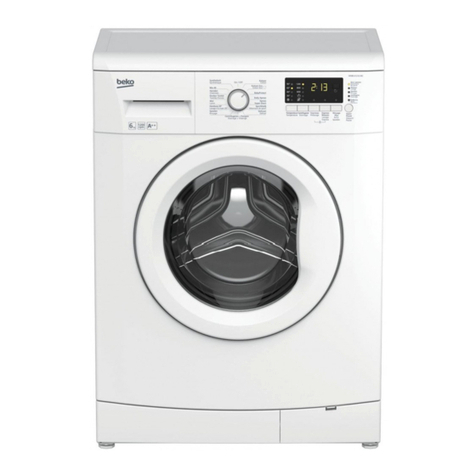
Beko
Beko WMB 61232 MC User manual

Beko
Beko WTA 9712 XSW User manual

Beko
Beko WER860541G User manual

Beko
Beko WTX71232WI User manual
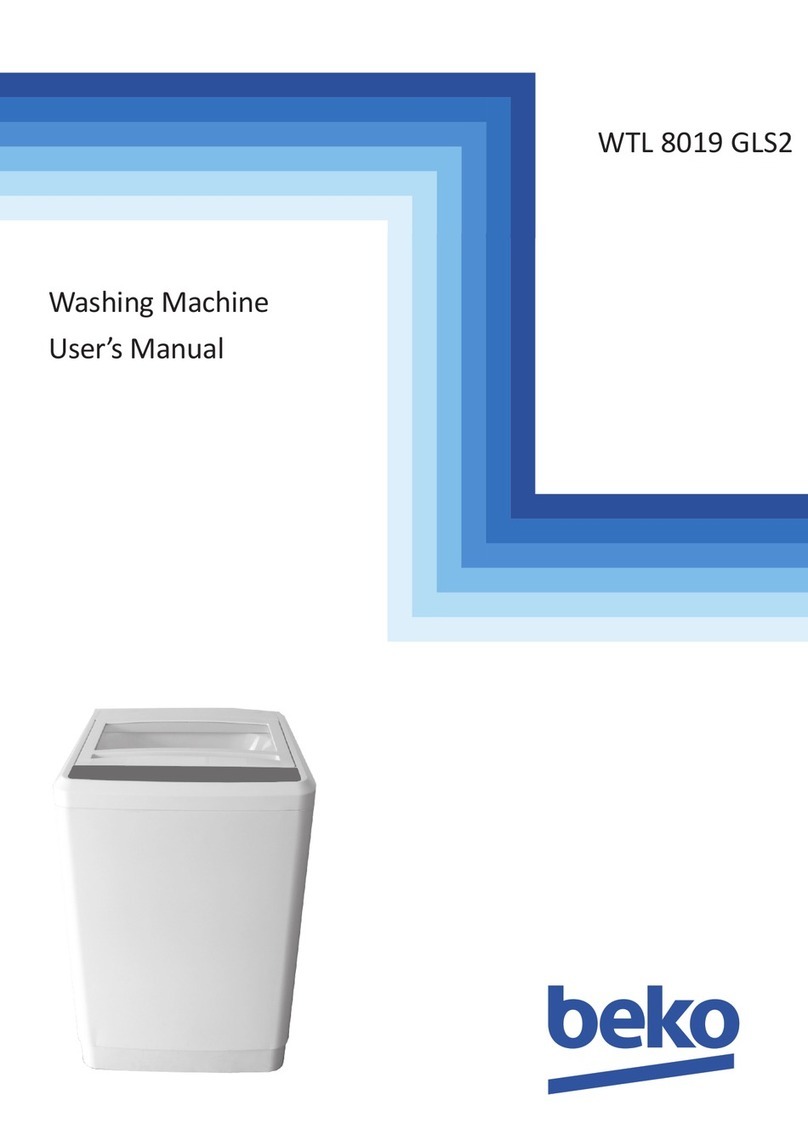
Beko
Beko WTL 8019 GLS2 User manual

Beko
Beko WUE 7726 XWST User manual
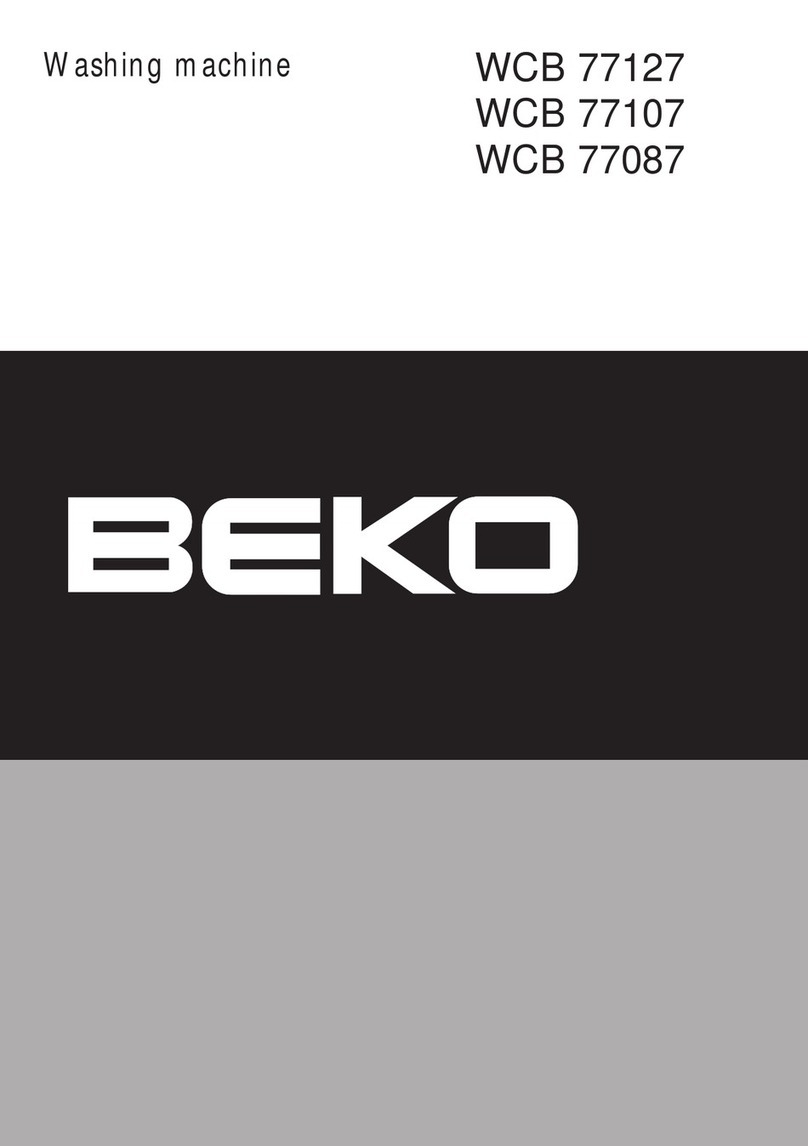
Beko
Beko WCB 77127 User manual

Beko
Beko WTV 9636 XS0 User manual
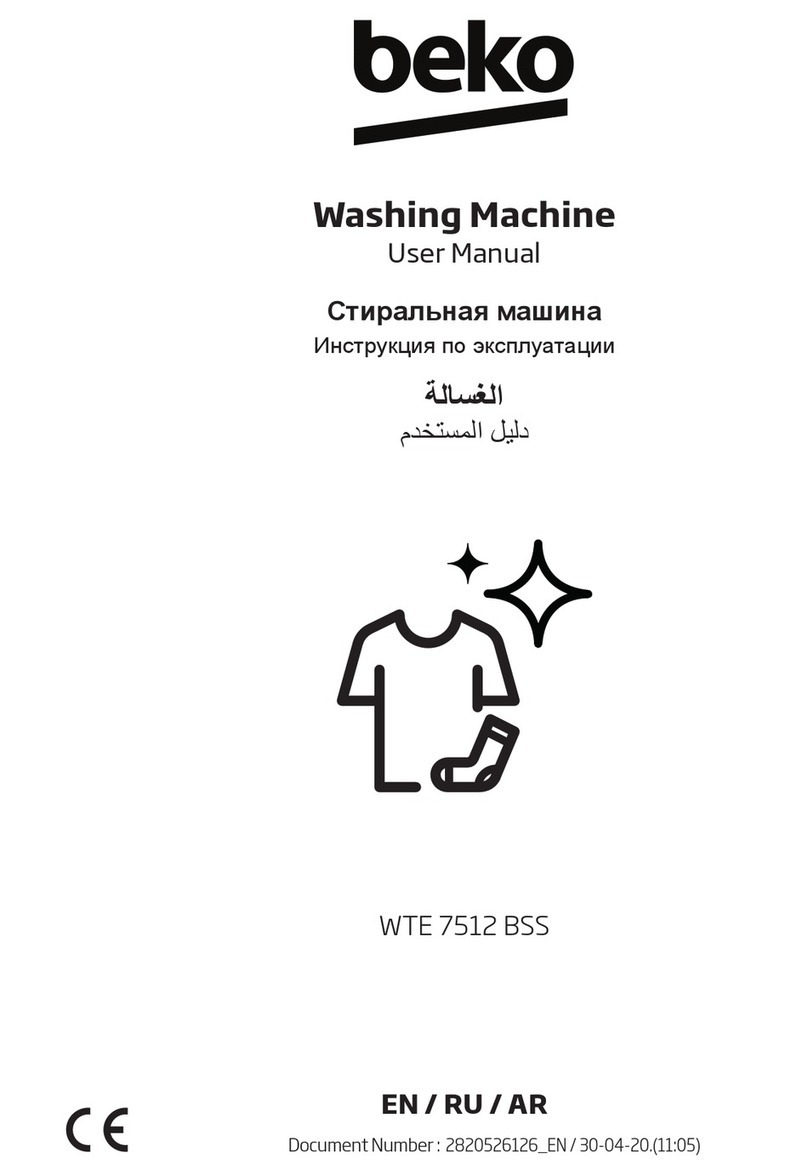
Beko
Beko WTE 7512 BSS User manual
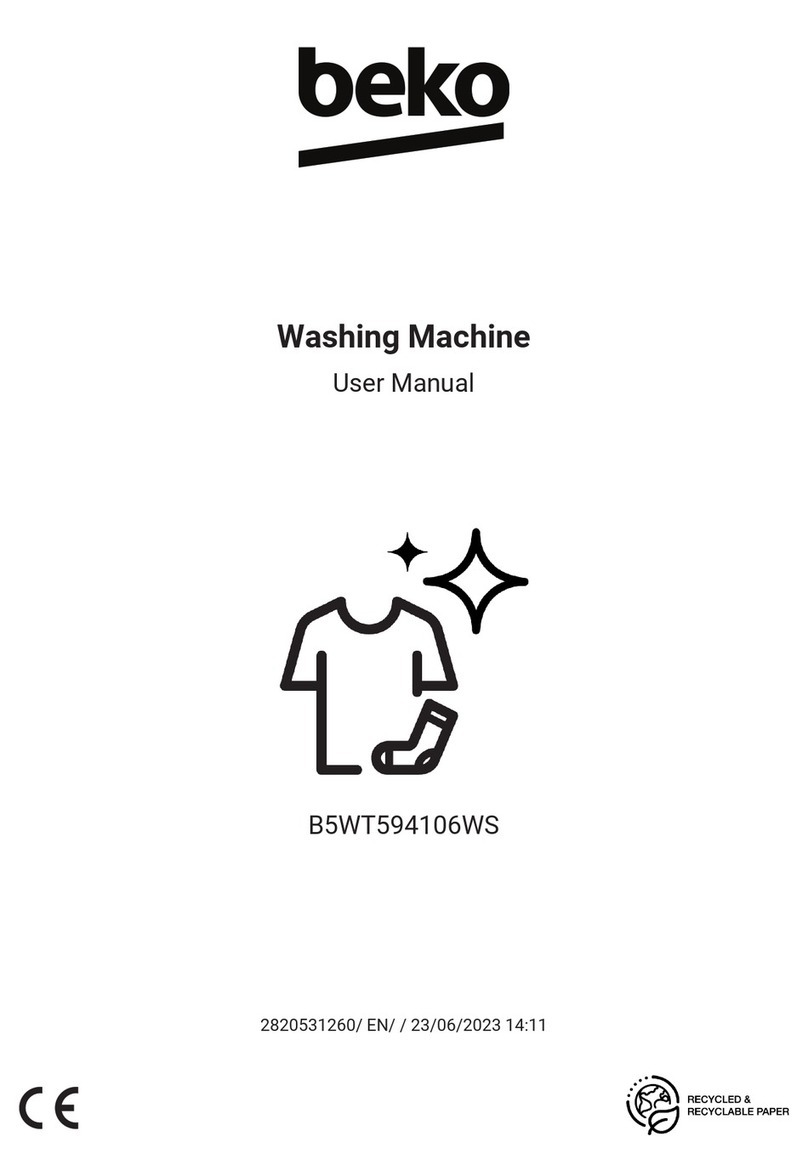
Beko
Beko B5WT594106WS User manual

Beko
Beko HTV 8633XS0 User manual

Beko
Beko WTV10713XWPT1 User manual
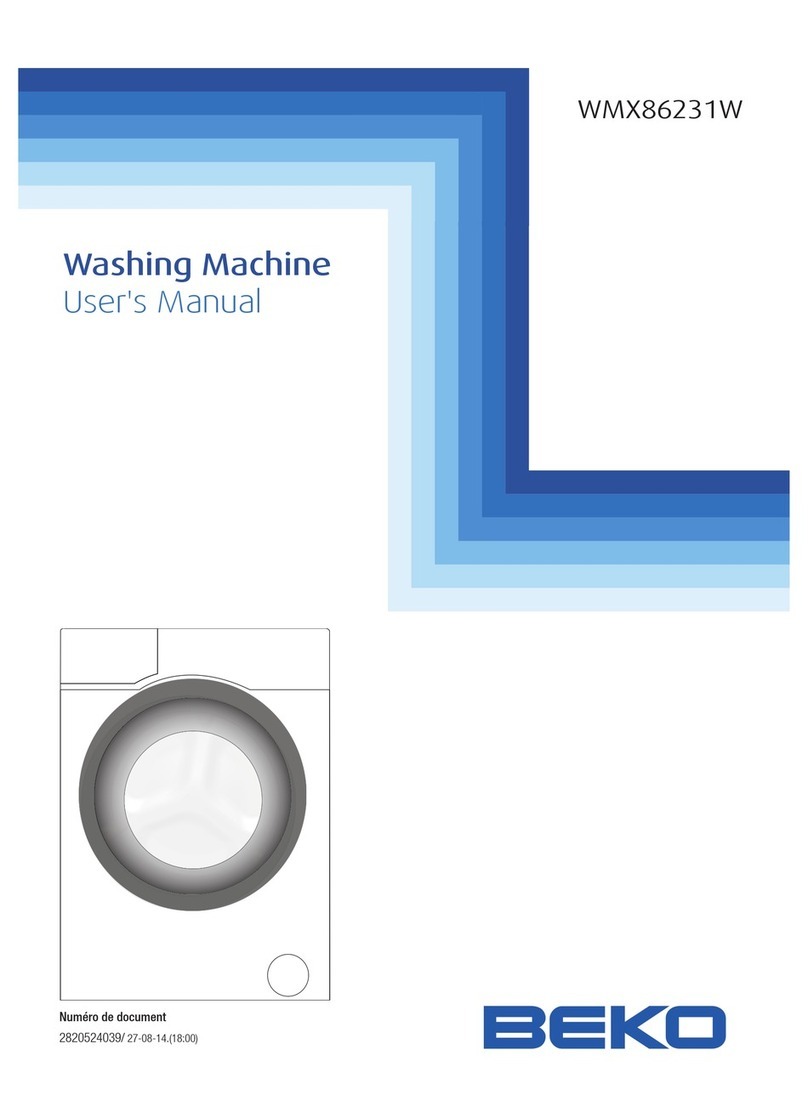
Beko
Beko WMX86231W User manual

Beko
Beko WTV9744 X0 User manual

Beko
Beko WTV 6732 B0 User manual
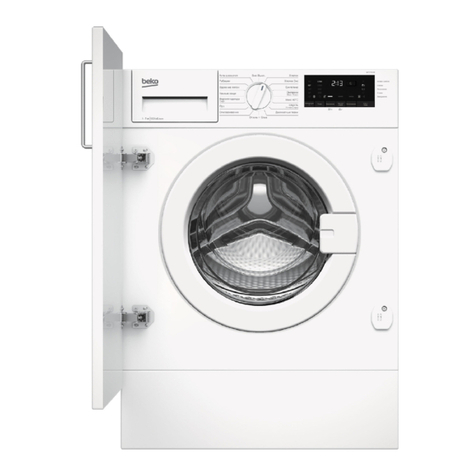
Beko
Beko WITC7652B User manual

Beko
Beko WMB 61042 PT User manual

Beko
Beko UWR91436AI User manual

Beko
Beko WMB 81241 L User manual


